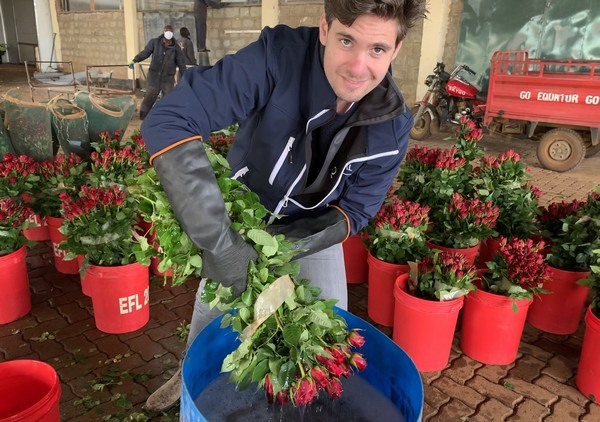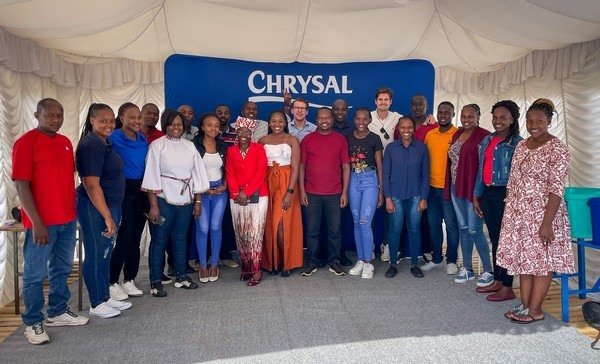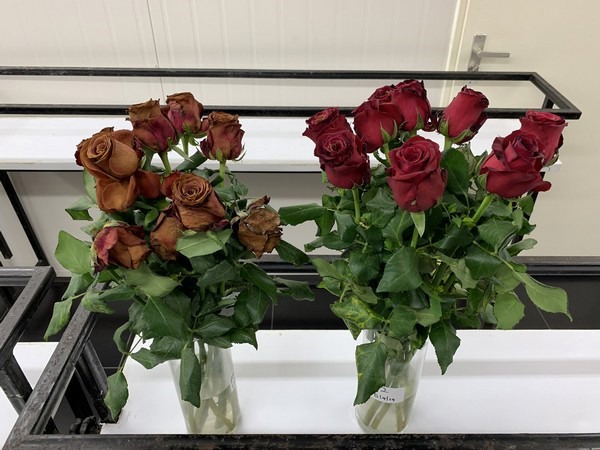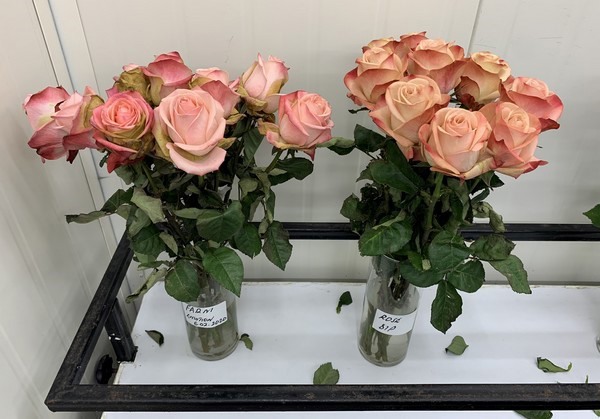"There is a lot of attention for sea freight of flowers, both within and outside the sector, and that is excellent. But what not everyone knows is how we actually got here. Together with other parties, Chrysal spent ten years researching and investing several million until we finally completed the final registrations of our 'Rose Dip service' in 2019. It is since that moment, and only since that moment that it has been possible to successfully export flowers by boat from Kenya to Europe."
Niels van Doorn in 2019 when Chrysal had just started to roll out the Chrysal Rose Dip service.
We speak to Niels van Doorn, General Manager of Chrysal Africa. Consumers know the company for its cut flower food, but growers and traders certainly know Chrysal for its post-harvest treatments. The Chrysal Rose Dip service is a new post-harvest treatment, a service in which farm workers are trained by Chrysal Technical Assistants and which allows the rose not only to survive the 30 days at sea but even to emerge in very good condition - if all other factors are met. Because there are so many factors to consider, an important part of the service is the collection and sharing of data with farms and buyers to identify and improve any process pain points.
Mastering botrytis
"For flower transport, good pre-treatment and a good cold chain are important," says Niels. "Our products help the flower to hydrate. Maintaining a constant, low temperature and guaranteeing optimal oxygen and carbon dioxide levels during transport is up to the logistics. Those technologies are there at 0.5 degrees, and under the right atmospheric conditions, you can cover a lot of time. But with sea freight, and certainly, where roses are concerned, there is a third point: combating Botrytis. What we have now developed is exactly that, a protection against the development of Botrytis."
If these three conditions are met, then in principle, nothing stands in the way of the large-scale roll-out of sea freight. "We have already had weeks when 5% of the total rose production was shipped by boat. That amounts to about 25 containers. At the moment, all sea freight roses are handled by Chrysal."

The dip team, or in full "Chrysal Africa Rose Dip & Sea Freight team."
The way up
At the same time, it is true that these volumes can and, as Niels knows, will become much larger. "Next year we will be at 10%, the year after that at 20%, and then it will go even faster, to eventually reach at least 50-50." What stands in the way of that is a number of things. "The market has to give up flexibility, not only in time but also in being able to order specific colors and types as late as possible. For large retail, where purchases are more often made on contract, this is easier. One will want to keep a certain flexibility, hence the 50-50, but for the standard flows, it is a godsend. In addition, there must be a critical mass. For a Maersk or CMA CGM, 10 or even 50 containers a week is peanuts, but at a certain volume, it becomes significant. Then there will be more focus, and it will no longer just happen that a container arrives with a two-week delay. You always have to allow for a few days' slack, but if you exceed 40 to 45 days of transport, the quality suffers."
Despite the sustainable benefits that are much talked about, it is often still a simple cost-benefit analysis for entrepreneurs. "In South America, we are stuck at 10 to 15% sea freight because the need is not high enough: due to the ample and affordable air freight supply, the profit is minimal, despite the sea freight trip being half that from Kenya. Because those factors are different for us, that profit is now possible."

Both above and below, untreated roses vs. dipped in Chrysal Rose Dip. The treated specimens have no botrytis, have kept their color or even deepened it, open uniformly and have a longer vase life.

Retail pays
Finally, it is striking that in European practice, it is usually the retailer or purchaser who pays. This too is a typical cost-benefit analysis. "In the event of losses, only the purchase price of the flower can be recovered, but the buyers lose out on the transport costs they pay - which are often higher than the stem price. If the pre-processing is in order and therefore the loss can be reduced by x percentage, then it is a simple sum - this applies to both air and sea freight, by the way. Because it works out like that, they are prepared to take on the costs themselves."
Most sustainable partner
The shipping industry and forwarders are watching the developments with great interest and are explicitly looking for cooperation with Chrysal. For its part, Chrysal does the same, but without committing to specific parties, in its own words, "to meet the higher sustainable goals and keep our solutions accessible to everyone." In Kenya alone, Chrysal has about twenty people in the field, going to the farms and assisting them with post-harvest treatment and data collection. "No matter how big or small the grower or the volume on the total, Chrysal wants to be the most sustainable partner for every customer."
For more information:
Chrysal 
Niels van Doorn
E: [email protected]
www.chrysal.com










